Coney Island - Early Years
(1609-1880)
Revised November 19, 1997
When Henry Hudson first sighted the beach at Coney Island in early September 1609, the land was nothing more than desolate sand dunes, clam beds and wind blown scrub that stretched for five miles along the shore of the Atlantic Ocean. It was a mere sand-spit just beyond lower New York Bay about five miles south of Manhattan in what would become Brooklyn. His ship the "Half Moon", was in search of a new route to seek spices, gems and perfumes of the fabled Indies (Asia).
Hudson anchored his ship in Gravesend Bay, west of Coney to trade with the Canarsie Indians. He offered them knives and trinkets for their corn and green tobacco, but the next day they attacked his shore party on a combined fishing and exploring excursion. Hudson's men might have won the skirmish if the rain hadn't put out the taper the men needed to fire their muskets. John Coleman, a petty officer commanding the expedition, was killed by an arrow to his throat. What Hudson and his men didn't realize was that the Canarsie Indians used Coney's marshes by the sea for making money in times of peace, and for hiding their wives and children in times of war. Both for financial and person reasons they couldn't tolerate any Coney Island excursion by white men. The following day the Indians rowed out to Hudson's ship to trade again as if nothing happened. They were allowed to return to shore, but the next day Hudson seized two Indians as hostages just before they sailed up the Hudson River.
In 1645 Dutch officials, during a lull in the Indian Wars, offered to let a group of English religious dissenters from New England, led by Lady Moody, establish a colony at Gravesend near the beach. They figured the colony would be a buffer for them from the Indians who used the beach to collect clams and wampum (strings of beads made from periwinkle shells - used for money).
Dutch officials assured Lady Moody that the local indians belonged to the big-animal Bear Band known as Konoh, and were no danger since they only used the oceanfront area as a hideout for women and children. They called it "Konijn Hok," the rabbit's hutch or breeding place, a pun on the fact that genuine rabbits or coneys shared the beach with the Indians.
When the war resumed several months later because a governor of New Amsterdam kept presents intended for the Indians, the Bear Band made a vicious attack on Lady Moody's hastily erected log house at Gravesend. The colony's forty white men were barely able to beat off the attack. The settlers prudently sought temporary refuge in the neighboring Dutch settlement of Amersfoort until the war ended.
Lady Moody guided and shaped the colony at Gravesend along tolerant and almost socialist lines during its first sixteen years. When they laid out the town, each of the thirty-nine original settlers received an equal share of the sixteen-acre plot inside the palisade and a corresponding pie shaped segment of the farm land outside. It was a primitive democracy with all decisions made at the town meeting. Those that didn't attend were subject to fines.
Lady Moody was attracted to the nearby coast because she had grandiose plans to found a port that would rival New Amsterdam (Manhattan). Unfortunately the bay proved too shallow for large boats and her plan for a maritime city was abandoned. The colony, however, was blessed with fairly fertile farm land and a considerable amount of neglected seaside property that would eventually become the site of the most famous summer playground in the world.
Lady Moody advocated decent treatment for the local Indians and even negotiated with them for grazing rights in the marshes despite already been granted those rights by the Dutch. On May 7, 1654 an Indian named Guttaquoh, declared to be the owner of "Coyne Island *," (he called it Narrioch) formally put his mark on a deed conveying the Island to the forty Gravesend patentees. Unfortunately the local Indians were completely wiped out in 1655 by the rival Mohawk Indians for failing to pay tribute to the Five Nations. Being poor and under-armed, they mistakenly believed that the Dutch would protect them.
Note: The original Dutch name "Konijn Kok" first evolved to "Conyne Island" by the English and later to the easier sounding Coney Island. However, there are other explanations of the origins of the name. Judge Egbert Benson, in a report to the New York Historical Society in 1816, argued that "Coney" came from "Conyn" the name of a Dutch family that once lived at the beach. Some believe that the area was named after John Colman, the officer aboard Hudson's "Half Moon" ship, who was killed by the Indians. The name eventually evolved to Coney Island.
In 1663 a Dutch merchant named Dick de Wolf, having been granted a monopoly on salt manufacture in the new world by the Dutch East Indies Company, started a salt works on the nearby beach. The Gravesend farmers were furious when he ordered them to remove their cattle and cease cultivating hay on the salt meadows. They promptly destroyed De Wolf's garden, ripped out his protecting palisade, burned the wood, and threatened to feed De Wolf and his foreman to the flames.
When news reached the Dutch Indies Company in Holland, they ordered Governor Stuyvesant of New Amsterdam to dispatch soldiers to Coney Island at once to restore the salt works and drive away the invaders. The governor, realizing that to follow orders meant war between New Amsterdam and Gravesend, found excuses to disobey his orders for several months.
Meanwhile The English were in the midst of a series of Anglo-Dutch wars raging in Europe. On orders of Charles II, they surprised the Dutch by surrounding New Amsterdam with a British fleet boasting 120 guns and 500 veteran troops. Since the Dutch defenses included only 20 cannon and 250 soldiers and militia, the townspeople implored the governor to avoid bloodshed and destruction. Luckily for the citizens of Gravesend, who thought their tiny war was imminent, England took possession of New Amsterdam on September 5, 1664. Gravesend won possession of all of Coney Island without firing a shot.
During the early 19th century there was considerable discussion among the community of building a shell road across the creek to the nearby beach, since the only existing approach involved crossing the creek at low tide. Nothing occurred until 1823 when Supervisor Terhune and others formed the Coney Island Road and Bridge Company as a private enterprise. They sought funding through a stock issue of 300 shares at $20 / share. The shares were purchased quickly and in 1829 the company built the Shell Road across the creek that separated Coney Island from the mainland. They also built a hotel called the Coney Island House which marked the beginning of summer resort business.
In 1830 pirates, who had seized the brig Vineland and its treasure of $54,000 in Mexican silver, sailed the ship north, set it afire and scuttle it near Coney Island. They rowed ashore in a nasty gale and lost most of the loot near Rockaway Beach. They buried what remained, about $5000.
They stayed at a local inn and one of the men confessed to two of the other borders. Before the repentant pirate could return with the local justice of the peace, the Johnson brothers had dug up the treasure and hidden it in two parcels further east. Meanwhile winter tides had swept the beach and by the time one of the brothers dug it up, he could only find the larger of the two parcels. A fierce winter storm in 1839 finally exposed the remainder of the loot. A resident discovered the coins lying on the beach (what was to become Manhattan Beach), and when two other neighbors came along, they couldn't keep silent. The news spread rapidly and by the next day, hundreds of residents from Gravesend and nearby towns were at the beach sifting the sand for coins.
During the early 1840's John Wyckoff, an elderly Gravesend schoolmaster opened a hotel to rival the Coney Island House. His hotels and one or two others catered to excursionists wealthy enough to own carriages. Some of these hotels were especially prone to fire and burned down within a year or two of being built. These excursionists, as many as 300 on a busy summer Sunday, were offensive to Gravesend's more religious and virtuous parishioners. They felt that their presence was a shameful breach of the Sabbath peace.
Nearby Brooklyn wasn't too happy with the intrusion of vehicles passing churches conducting Sunday services on their way to Coney Island. Its upper register suburban residents made attempts to ostracize those who ventured to Coney Island and who enjoyed the hot meals on the Sabbath (cooking on Sundays was considered impious.)
Still the Coney Island House and various other hotels attracted many notables during the late 1840's. Washington Irving brought his niece to Coney Island on September 1, 1848 and Herman Melville, author of Moby Dick, visited a year later. Jenny Lind, the Swedish nightingale, was accompanied by Phineas T. Barnum in 1850. Politicians frequented the island, too. All three of the great pre-Civil War politicians, Daniel Webster, John C. Calhoun and Henry Clay stayed at Coney Island House. Other visitors included General Sam Houston and New York's Governor Edwin Morgan. Visitors watched the waves from comfortable porch chairs, ate clam chowder, went for a quick dip in the ocean surf or went snipe or duck hunting in the nearby marshes.
Additional tourist development began in 1846 at the far westerly point of the beach that was later to be known as Norton's Point. Two New Yorkers, Eddy and Hart, built a pavilion (circular wooden platform covered by a tent) there. The following year a little side-wheeler steamer on an irregular schedule began to bring visitors from Manhattan to a small pier that jutted out into Gravesend Bay. The boat trip, much faster than the half day ferry and stagecoach route, cost only fifty cents and required a mere two hour sail down the bay.
Unfortunately this area also attracted a rougher element. Political and other groups found the Point ideal for outings that encouraged heavy drinking and fighting. Gamblers, attracted by the moneyed crowd, set up three-legged tables where they plied on the gullible in often crooked "skin" games of thimblerig, the old shell game, three card monte, and chuck-a-luck, a dice game. The wealthier guests at the hotels in the center of the island were appalled by the low-class riff-raff that frequented the Point.
Peter Tilyou and family moved to Coney Island in 1865 to establish the Surf House, a hotel and restaurant which sold Bavarian Lager for five cents. Tilyou treated those, who rented a bathing suit for 25 cents, a free bowl of homemade clam chowder on the theory was that those that were hungry would spend more money for food at his restaurant. He built bath houses nearby for those who wished to change from their city clothes into fancy full length flannel bathing suits. "Signs on the beach warned "Bathers Without Full Suits Positively Prohibited by Law."
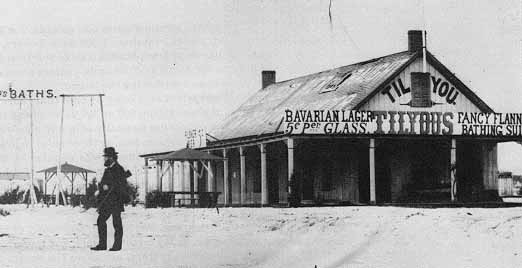
| Tilyou's Surf Bath House served food and rented bathing suits to visitors. |
Salt water bathing was a rather novel idea in the late 1860's and 1870's. It was an era when at best the closest city people came to voluntarily getting wet was the Sunday hot bath. Those that came to the beach were apprehensive of even sticking their toe into the sea for there were those that warned that sea bathing might "leach away the essential salts of the body." They turned to a noted physician named Dr. Durant for reassurance. He advised that "the bathing dress should be made of woolen fabric...as it retains the heat of the body and therefore prevents a too rapid evaporation. Maroon and blue are the proper colors as they resist the corrosive and bleaching effects of salt water. Some authorities recommended twilled flannel, in browns, blues and grays, and stressed the desirability of broad-rimmed hats to fend off the sun and wind, as well as shoes to guard against the nipping of crabs.
Overton's 1883 Coney Island Directory laid down the rules for bathing. "The dress should consist essentially of two parts - a pair of pantaloons and a blouse; the latter should not fit too tightly, the sleeves fastened loosely at the wrist and slits cut in the garment just below the armpits; a belt attached to the blouse to retain it at the waist. The pantaloons should not be buttoned too tightly to the ankles, as circulation would thereby be impeded. Men were urged to enter the water resolutely and briskly, until the water reaches the waist... If you can swim three strokes without going under, it is a fair start." Woman, however, were warned of the danger of hysteria if they entered the surf abruptly. Surprisingly only a small percentage drowned given the fact that a full length woman's woolen swim suit when wet must have weighted at least fifteen pounds.
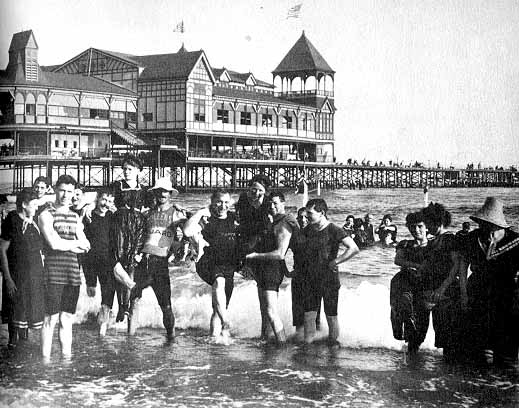
| Beach bathing near the Iron Pier - 1880's |
Bathers patronized a variety of establishments along Coney Island's beaches during the 1880's. These included the Manhattan Beach Bathing Pavilion, the Brighton Beach Bathing Pavilion, Mrs. Vanderveer's Voorhees', West Brighton Baths, and the Iron Pier Baths. Most provided ropes, poles and lifeboats for the protection of its customers.
Mike Norton, a notorious downtown New York politician, became interested in the area around the Point during the late 1860's. He acquired the summer home of William Wheatly, a theater manager in Revolutionary War days and erected several wooden shacks around the central house in what he would call his Point Comfort Hotel.
His influence in downtown New York ward politics drew some of the more successful shady characters to his shacks. These included contractors who had made fortunes selling moldy beef and cheap clothing to Civil War soldiers, and men who were rich with the rewards of dozens of fraudulent enlistments. They in turn were preyed on by gamblers, confidence men, pickpockets, strong-arm men and rowdies. And since prostitution was so prevalent in New York City, the world's oldest profession made a killing plying their wares within sight of the sea. While Gravesend authorities were outraged over the area's lawlessness, their little town of 500 residents could not afford a beach police force. Besides Mike Norton had grown too big to be tackled.
Things began to change for the better for Gravesend, at least initially, when John Y. McKane was elected as Gravesend's third constable in 1868. McKane was a small time building contractor in the village of Sheepshead Bay. He kept busy building ramshackle bathing establishments and lager-beer saloons for businessmen attracting the summer tourist trade. He was shrewd and knew how to judge character and when to advance credit. When people like the Vanderveers wanted to enter the bathhouse business, he built their structures on speculation. They not only paid him back in full, but became his political supporters when he decided to run for office.
He was honest at the time and felt that the town wasn't getting its fair share from leases on the town's common lands near the beach. His gripe wasn't that the town commissioners were dishonest, but that they were naive genteel farmers who knew nothing of the property's worth. He ran for office and at the 1869 town meeting was elected one of three commissioners. Within a year he doubled the town's rental income to $1511.50.
McKane was interested initially in making friends with the lessees and obtaining building contracts to build their establishments. But he also realized that many of these businessmen were sub-leasing their lots and making a substantial profit. He yearned for a way to obtain some of that profit for the town and even for himself.
The beach at Coney Island Point was booming because it was close to Manhattan by boat and it attracted many of Boss Tweed's corrupt friends, who frequented the beach on summer weekends. The resort area was within McKane's jurisdiction, but he found it prudent to look the other way. Despite its bad reputation, the big gamblers, politicians and their girl friends continued to come, and in droves. The area got such a sordid reputation that the middle and upper classes no longer referred to going to Coney Island but to the more civilized sections of the island like West Brighton, Brighton Beach and Manhattan Beach
In 1873 McKane authorized a new and much higher lease for Coney Island Point. While the rent before was only $400 a year, Robert Furey paid Gravesend $6100 a year. He was friends of politicians and had become rich by being Brooklyn's Street Commissioner while being a principal stockholder in an asphalt paving company.
In 1871 Charles Feltman, who several years earlier had invented the hot dog to sell from his hot food wagon, subleased a tiny plot of land on one of the big shore lots. He served hot dogs to 3,684 patrons that first season. After a few summer seasons he was successful enough to lease his own shore lot at West 10th Street from Surf Avenue to the beach where he built his Ocean Pavilion. In 1874 he paid $7500 for the restaurant property.
As more sand piled up on the beach, his original 150 foot wide by 200 foot deep lot grew by another thousand feet, giving Feltman enough space to steadily build a series of restaurants and beer gardens shaded by maple trees. German bands and Tyrolean singers entertained the customers. His food was excellent and the waiters, wearing clean white coats, served lager beer for 10 cents, 10 cent hot dogs and ice cream for ice cream for 15 cents. Even the upper classes, who frequented the race tracks, liked Feltman's garden where they could order high class fare and even special dishes devised by Feltman's chefs.
In 1878 Feltman built a 100 foot long Iron Pier with space for 1200 bath lockers and various game and food stands. Two years later he installed a Looff carousel in the beer garden and a collection of amusements, too. As his business grew and prospered he built a ballroom, large enough for 3000 dancers and a piazza for 5000 onlookers. It was decorated with paintings of German landscapes.
Charles Feltman would continue to run his restaurant until he died in 1910. He left his business, worth more than $1,000,000 to his sons Charles L. and Alfred Feltman and his grandson, Charles A. Feltman.
William Vanderveer arrived in 1873 and sublet two small beach lots for $2196. He met McKane, who built for him 12 bath houses the first year, 75 the next season, and 200 the following year. As a result of his friendship McKane, his annual rent on one lot dropped to $46 and $15 for the other. He was so successful that in 1875? he built a three story hotel and three story bathing pavilion. To provide amusements for his guests, he installed Coney Island's first carousel, carved by Charles Looff in 1875.
In 1876 it became much easier to reach Coney Island by road. The Ocean Parkway, a seventy feet wide roadway landscaped with trees and shrubbery was built from Brooklyn's Prospect Park to the ocean. It was nearly straight and was flanked by two gravel roads each twenty five feet wide, perfect for racing surreys.
During the next three years, business men, notably William Engeman who acquired the title to Brighton Beach, and August Corbin, a rich banker who acquired title to Manhattan Beach, decided to develop their respective property. Corbin became interested in the seaside during a visit to Coney Island House (Oceanic Hotel??) with his wife and ailing infant son. The child's doctor had recommended a few weeks of sea air. Corbin was a wall street investor and railroad tycoon who saw potential profits by building two large luxury seaside hotels and a railroad to bring in customers. His New York and Manhattan Beach Railway brought the shore within an hour of uptown New York.
Corbin sought a virgin tract of land east of West Brighton to build his hotels. He approached William H. Stillwell, surveyor of the town of Gravesend. The land and the deed that he sought belonged to DeWitt C. Littlejohn, an influential upstate Democratic leader. Littlejohn agreed to sell for what was considered an outrageous price, $80,000.
Corbin's Manhattan Beach Hotel was built on the far eastern shore of Coney Island. Architect J. Pickering Putnam set its nearly 700 feet long front with its covered verandas and acres of manicured lawns facing the sea. It was considered the most elegant and fashionable hotel in the United States. It featured 258 lavish rooms, restaurants, ballroom and shops. When Ulysses S. Grant delivered the dedication speech for the hotel's grand opening on July 4, 1877 the event and the free fireworks show drew such huge crowds that it overwhelmed Corbin's railroad. And those who once thought that Corbin overpaid for the land changed their minds and pitied Littlejohn for selling so cheap.
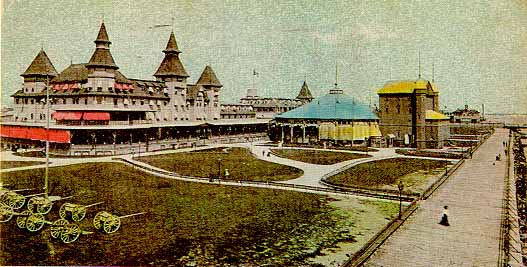
| The 800 foot long Manhattan Beach Hotel - 1890's |
The second resort that came into existence about the same time was William A. Engeman's Brighton Beach, located west of Manhattan Beach. Engeman had made his fortune selling more than a million horses and mules to the government during the Civil War. But to put together the land deal to build his magnificent Brighton Beach Hotel, required several years of patience and craft on his part. The ownership of the middle portion of Coney Island had been divided into thirty-nine parcels the previous century. The negotiations among the 300 seventh and eighth generation heirs would have taken decades if he hadn't charmed Judge William H. Stillwell, the town's surveyor and Justice of the Peace.
Stillwell obliged by placing on file in the town clerk's office, a map that declared all the Middle Division to be the property of William A. Engeman. Then he acted as Engeman's purchasing agent, no doubt at a handsome profit, with Engeman's name kept secret until all the lots had been purchased. He also obliged by including some of the town's common lands in his map of what Engeman actually owned, enabling Engeman to secure leases on those lands at trifling sums. Best of all, Engeman was able at a cost of only $20,000, to take possession of several hundred acres of prime ocean-front real estate long before he had actually purchased any part of it.
Engeman constructed his Brighton Beach Hotel in time for the 1878 season. This vast wooden hotel, 460 x 210 feet and several stories high, with accommodations for nearly 5000, could also feed 20,000 people per day. He also constructed an Iron Pier nearby and the 400 foot wide, two story Brighton Beach Pavilion. His resort was connected to New York by railroad and was frequented by the upper middle class rather than the wealthy because its location in Brighton was too close to Coney Island's seedier section immediately west of it.
The third and final big-time developer was Andrew R. Culver who ran a steam line to West Brighton shortly before Corbin and Engeman got their railroads started. His Prospect Park & Coney Island Railroad, called the Culver Line, terminated in 1875 at a spacious terminal on the ornamental Culver Plaza along Surf Avenue. It offered regular and speedy service to Coney Island for a 35 cent fare. However, it irked Gravesend's 2000 residents because Culver commandeered Gravesend Avenue, their original village road and its new $80,000 extension towards Brooklyn, to lay his tracks.
Opposite the station stood the 300 feet tall Iron Tower, a structure with steam elevators that whisked visitors to the top for a high view of Coney Island. Culver had purchased it from the 1876 Philadelphia Exposition. A Camera Obscura, which showed a panoramic view through a combination of lens and mirrors, also from the fair was installed nearby.
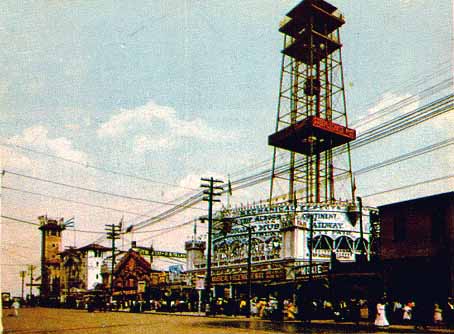
| The Iron Tower along Surf Avenue - 1903 |
Two large hotels were built nearby, The first, the 150 room Cable Hotel, was built by Thomas Cable, a friend of Culver. A larger one was built by Paul Bauer, a maitre-d' of a New York hotel who married the daughter of John J. O'Brien, Republican leader of the area east of the Bowery. Bauer choose a 12 acre lot close to Culver Plaza but it had already been leased to a Gravesender, James Voorhies for $75 a year. Since Voorhies only needed a strip of land along the beach for his flourishing bath house business, Voorhies paid him $1000 a year for the rights of his lease and charged him only a token dollar for use of the beach strip. Then he proceeded to sublease a fraction of his lot to other tenants for $13,000 a year. With capital provided by his rich father-in-law, He hired McKane to build for him the biggest hotel in West Brighton. When it was completed in May 1876 it could accommodate 250 guests and had a dining room that could serve one thousand at a time. Its four tower rooms were used for private banquets.
While there was no way for Andrew Culver to obtain exclusivity near his railroad terminal, others like McKane sensed rising real estate values and prosperity to their nearby restaurants and hotels. There was a marked increase of shops, saloons, houses of prostitution, eating establishments, sideshows and games in the vicinity of Culver Plaza. By 1878 more than 50,000 of the 60,000 visitors to Coney Island on a warm summer Sunday headed for West Brighton. McKane, who built many of the ramshackle restaurants, beer gardens and hotels nearby, took a lease on a the lot adjacent to the one rented to the Iron Pier Company.
The Iron Pier Company owned by Buel T. Hitchcock, had leased a lot nearly opposite Culver Plaza. They built the New Iron Pier there in 1880, about 350 feet east of the Old Iron Pier. The company owned a fleet of side-wheeler steamships that brought passengers from Manhattan at twenty minute intervals during the summer tourist season.
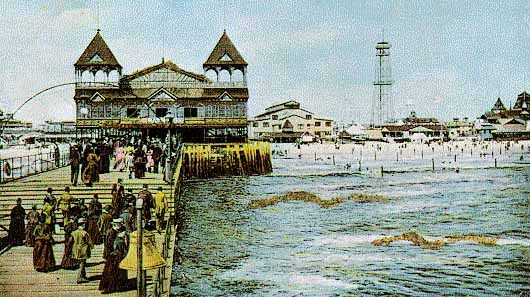
| The Iron Pier - the 300 foot Iron Tower is in the distance. - 1880's |
The final syndicate to provide rail transportation to the island in 1879 built their New York and Sea Beach Railroad that terminated at their Sea Beach Palace. Their enormous combination terminal, restaurant and hotel was located on Surf Avenue several blocks west of Culver Plaza. It boasted that it could accommodate 10,000 guests overnight and serve 15,000 diners at one sitting.
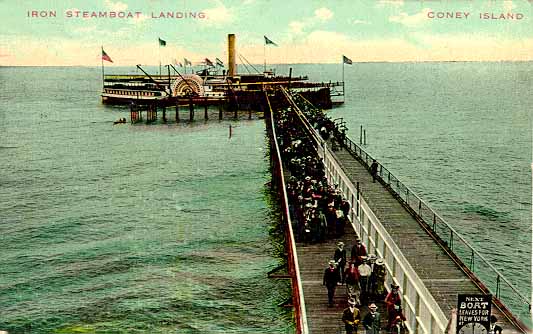
| Steamships, arriving at the Iron Pier, brought tourists from New York City. - 1890's |
To gain political control of Gravesend McKane had to become commissioner, an office that had always been held by the Gravesend gentry. While the town's income from the common lands was now $17,500, the gentry was well aware that if the land had been leased at public auction, it would have netted them at least $200,000. Wishing to be rid of McKane, they had under estimated McKane's ability to cultivate generous friends. When election time came in 1879, McKane was swept into office.
When Corbin sought the town's common land east of his Manhattan Beach property for his new Oriental Hotel, a four story edifice capped by exotic minarets, McKane tipped off Corbin that a sale could be authorized by a voice vote at the annual town meeting. Corbin packed the meeting with two hundred thugs armed with clubs. Amidst the confusion, they pushed a resolution through authorizing the sale of the property at a price determined by the town's appraiser who was in the pay of Corbin. While the land was certainly worth $100,000, Corbin greed to pay only $1,500. The town gentry was outraged and they called three separate town meetings to protest and reverse the sale. But each time Corbin's thugs obstructed their will, while McKane controlled the meeting and got his way. While no one knows how much Corbin paid to buy McKane, they each got what they wanted. McKane would control the political fortunes of Coney Island from that time on.